Chief William J. Walsh
BIRTH 1869
DEATH 9 Jan 1912 (aged 42–43)
Manhattan, New York County (Manhattan), New York, USA
BURIAL
Holy Cross Cemetery
Brooklyn, Kings County (Brooklyn), New York
Consumed in Fire, Cloaked in Ice, Equitable's Headquarter Fell 100 Years Ago
By DAVID W. DUNLAP
If that enormous White Star liner had made port on her maiden voyage that year, 1912 would probably have been known by generations of New Yorkers as the year of the great Equitable disaster.
The world seemed to end in fire and ice on Jan. 9, 1912, when the "city's first skyscraper" — as The New York Times called it — erupted like a sumptuous Second Empire volcano on lower Broadway. Horse-drawn fire trucks clattered to the scene from around Manhattan and thundered to the island over the Brooklyn Bridge, but to no avail, as temperatures dipped to 16 degrees and winds gusted up to 68 miles an hour. Water was turned to spray, spray was turned to ice and soon the equipment and then the enormous structure itself were turned into fantastic frozen sculptures.
Battalion Chief William Walsh was killed on the fourth floor as the interior of the building collapsed around him. Five other men died, including three who had trapped themselves on the roof seeking a route to safety. Extension ladders were far too short to reach them. A lifeline shot over from a nearby tower burned and snapped before they could use it. Rescuers and bystanders then watched helplessly as they tumbled — one by one — into the inferno behind them.
A fire that had begun at dawn was not under control until nightfall. "Darkness settled on a structure marvelously sheathed in ice with the blaze of the timbers within still red," The Times said.
The Equitable Building, once promoted as "fire-proof," was a total loss, though the elaborate granite facade remained standing, foreshadowing the haunting sight of the World Trade Center facades with nothing but sky behind them.
The Equitable Life Assurance Society of the United States, on the other hand, fared much better. It had already weathered a national scandal in 1905 that centered on extravagant self-dealing by its officers and the founder's son. And it was prepared, to some degree, for the catastrophe of 1912. Many of its most current records were being stored nearby on Albany Street. The vault containing millions of dollars in securities, stocks and bonds came through the fire intact. As a matter of fact, the company had been planning to replace the old building.
According to a 1929 company history, agents paused that morning only to send notes of support to the home office, then went out and wrote policies. (The account did not note how many were asked, "Why would I want to be insured by a company whose headquarters just burned down?".
By 1915, a massive new Equitable Building stood on the same block, bounded by Broadway and Cedar, Nassau and Pine Streets. Today, as a subsidiary of the French financial giant AXA, the AXA Equitable Life Insurance Company has its headquarters at 1290 Avenue of the Americas, between 51st and 52nd Streets.
The old Equitable Building was constructed in stages beginning in 1869, 10 years after the company was founded. Eventually, it rose to 10 stories, tall enough in its day that the rooftop observation deck was a popular tourist attraction and the site of the city's weather bureau.
"This substantial building, not unlike a massive fortification, served as an object lesson — the stability of the structure seeming to typify the future strength and magnitude of the society," William Alexander wrote in "A Brief History of the Equitable Life Assurance Society of the United States," published in 1929.
Shortly after 5 a.m. on Tuesday, Jan. 9, 1912, a small fire began in a basement office serving the Cafe Savarin. After causing moderate damage, it found a greasy dumbwaiter shaft that ran to an eighth-floor kitchen. Then the conflagration really began. The first fire alarm was sounded at 5:34 a.m.; four engine companies and two ladder companies responded.
A second alarm at 5:55 brought John Kenlon, the chief of the department, and five more companies. Third, fourth and fifth alarms were sounded, and more and more firefighters arrived on the scene, cater-corner from Trinity Church. Finally, at 7:48 a.m., a special call went to Brooklyn for nine more engine companies and four more ladder companies.

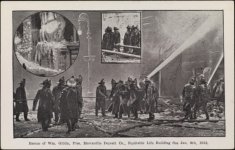
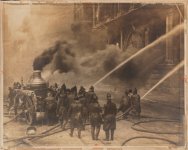
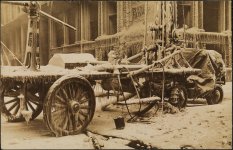
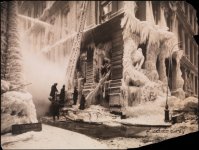
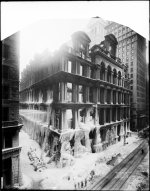
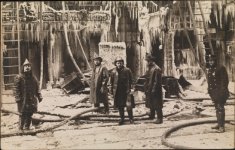


 postcardhistory.net
postcardhistory.net
